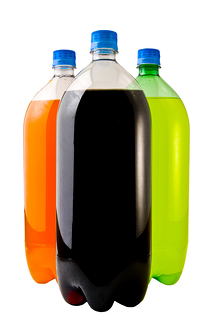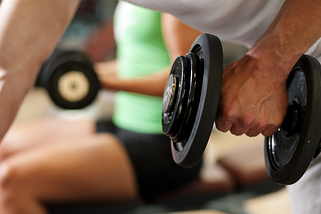This blog was written by Jenna Pearson. Meet our blogging fitness specialists at the NIFS website.
 In 2010, the average American consumed over 44 gallons of carbonated soft drinks! While this number does include diet beverages, it does not take into account the number of non-carbonated, sugared soft drinks (such as lemonade, iced tea, juice, sports drinks, etc.), which tally up to about 17 gallons per person per year!
In 2010, the average American consumed over 44 gallons of carbonated soft drinks! While this number does include diet beverages, it does not take into account the number of non-carbonated, sugared soft drinks (such as lemonade, iced tea, juice, sports drinks, etc.), which tally up to about 17 gallons per person per year!
Looking at those numbers from a nutritional standpoint is eye-opening to say the least. Here are the facts, according to CalorieKing:
- A single, 20-ounce bottle of regular soda contains about 250 calories and 17 teaspoons of sugar (70.9 grams).
- An 8-ounce serving of apple juice contains about 120 calories and more than 6 teaspoons of sugar (26 grams).
- A 32-ounce sports drink contains 200 calories and nearly 14 teaspoons of sugar (56 grams).
- A 12-ounce glass of sweet iced tea contains 130 calories and more than 8 teaspoons of sugar (35 grams).
- A 12-ounce glass of lemonade contains 150 calories and almost 10 teaspoons of sugar (40 grams).
For those keeping track, these numbers show that the average non-diet soda contains about 12.5 calories and .85 teaspoons of sugar per ounce, while an average non-diet, non-carbonated soft drink contains about 9 calories and .6 teaspoons of sugar per ounce. This means that if the average American did not consume diet beverages in the figures above, he or she would have consumed roughly 70,400 calories and 4,787 teaspoons of sugar from carbonated beverages AND 19,584 calories and 1,306 teaspoons of sugar from non-carbonated beverages. That’s a total of 89,984 calories and 6,093 teaspoons of sugar!
Do you see yourself in these numbers? Are you trying to lose weight? If so, think about this: If you were to ditch your sugar and calorie-laden drinks for water—and make absolutely no other changes to your diet or physical activity level—you could lose up to 26 pounds in a year.
Yup, that’s right, 26 pounds.

 Financial Problems Cause Stress
Financial Problems Cause Stress Habits are hard to break. This is especially true when it comes to your health. It’s very easy to fall into routines of not exercising, late-night snacking, eating out, watching several hours of television, and so on. In addition to diet and exercise-related health rituals, other behaviors that can be detrimental to health and similarly very hard to break free of include smoking, excessive alcohol consumption, excessive caffeine consumption, and self-loathing (or having a negative self-image)…and we all know how hard those can be to overcome!
Habits are hard to break. This is especially true when it comes to your health. It’s very easy to fall into routines of not exercising, late-night snacking, eating out, watching several hours of television, and so on. In addition to diet and exercise-related health rituals, other behaviors that can be detrimental to health and similarly very hard to break free of include smoking, excessive alcohol consumption, excessive caffeine consumption, and self-loathing (or having a negative self-image)…and we all know how hard those can be to overcome! Motivation Ideas
Motivation Ideas With more and more studies indicating just how dangerous to health sitting at a desk can be, incorporating small bouts of physical activity throughout the workday is as important as ever.
With more and more studies indicating just how dangerous to health sitting at a desk can be, incorporating small bouts of physical activity throughout the workday is as important as ever. It’s probably just my desire as a wellness center manager at a Continuing Care Retirement Community for the
It’s probably just my desire as a wellness center manager at a Continuing Care Retirement Community for the  As the summer months are moving past,
As the summer months are moving past,  In the world of technology, time equals improvement and efficiency. Back in the day we had computers that occupied the space of an entire room and Zack Morris–sized cell phones. Now we have computers that fit in the palm of a hand and Zoolander-sized cell phones. It seems that as more is discovered in the world of technology, items have become smaller and more efficient. Interestingly enough, this concept does not seem to apply to people.
In the world of technology, time equals improvement and efficiency. Back in the day we had computers that occupied the space of an entire room and Zack Morris–sized cell phones. Now we have computers that fit in the palm of a hand and Zoolander-sized cell phones. It seems that as more is discovered in the world of technology, items have become smaller and more efficient. Interestingly enough, this concept does not seem to apply to people. To fully understand the relationships that exist between positive emotions and food choices, researchers dissected the traits that classify personalities as happy and/or hopeful. They found that those with hopeful personality traits focus mainly on the future, while people with happy personalities tend to beam from past achievements. In looking toward the future, hopeful people choose more health-conscious snacks, and also exhibit greater levels of self-control than their happy, prideful counterparts who are simply “living for the moment.”
To fully understand the relationships that exist between positive emotions and food choices, researchers dissected the traits that classify personalities as happy and/or hopeful. They found that those with hopeful personality traits focus mainly on the future, while people with happy personalities tend to beam from past achievements. In looking toward the future, hopeful people choose more health-conscious snacks, and also exhibit greater levels of self-control than their happy, prideful counterparts who are simply “living for the moment.” Rumor has it, you build muscle by lifting weights, doing cardio, and being physically active every day. Okay, that is important along with a balanced nutrition plan; but in reality, muscle is built during your recovery phase.
Rumor has it, you build muscle by lifting weights, doing cardio, and being physically active every day. Okay, that is important along with a balanced nutrition plan; but in reality, muscle is built during your recovery phase.